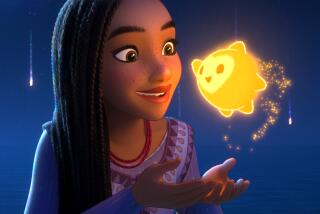An Alternative Fairy Tale : THE NIGHT OF WISHES: Or the Satanarchaeolidealcohellish Notion Potion, <i> By Michael Ende Translated from the German by Heike Schwarzbauer and Rick Takvorian (Farrar Straus & Giroux: $16; 217 pp.)</i>
- Share via
German writer Michael Ende is a passionate and ingenious defender of the imagination in a world that is becoming increasingly standardized and homogenized.
Best known for “The Neverending Story” (1983), Ende creates fantasies for children and adults that are often rooted in the richly imaginative world of German Romanticism. Although the sources of his inspiration are very German, Ende has developed an international following: His books for children and adults have appeared in 30 languages and sold more than 5 million copies.
Unfortunately, many people only know “The Neverending Story” through the big-budget European film of the same title. As often happens when worthwhile books get turned into movies, the author felt that the film was a travesty of his novel. In the book, Ende weaves the emotional life of a fat, lonely boy so seamlessly with the imaginary world of Fantastica that we willingly accept the young hero’s ability to step into the pages of the story he is reading.
Ende has not always had an easy time of it with critics. Tired of being continually labeled an escapist writer, he left Germany in 1970 for Italy, where he wrote two widely acclaimed novels, “Momo” and “The Neverending Story.” In his latest book he aims a few barbs at the film industry--the devil says that nothing authentic ever comes out of Hollywood--and at critics, those “little spirits who spend their lives grumping about books.”
At the risk of sounding like one of those book grumps, I must admit that I did not find “The Night of Wishes” as compelling as “The Neverending Story” or as moving as “Momo.” Still, I enjoyed it almost as much as did my 11-year-old daughter, who, for the record, preferred it to “Momo.”
There are two archvillains in this updated fairy tale: Beelzebub Preposteror, crafty sorcerer, and Tyrannia Vampiretta, a money-mad witch. Both have signed a Faust-like pact with their devilish superiors promising to destroy at least 10 species of animals and 10,000 of trees by midnight on New Year’s Eve. Doomsday is imminent unless the two unlikely heroes--Morris, a flabby cat, and Jacob, a bedraggled raven--can find an antidote for the magic potion being brewed by Beelzebub.
Some readers, especially those who associate fairy tales exclusively with children, may balk at the idea of a fairy tale with an environmental message. Yet Ende is working within a recognizable tradition, that of the subversive fairy tale.
As a number of scholars have pointed out in recent years, the fairy tales retold by the Grimm brothers can be didactic, authoritarian, misogynist, even downright savage. Every important German-language writer from Franz Kafka to Gunther Grass has felt an urge to play with or subvert the Grimms, whose collection of fairy tales has long been the best-selling book in German after the Bible. As for Michael Ende, he has a lot more in common with Hermann Hesse, who wrote many fairy tales and was fascinated by German Romanticism, than with a writer such as J. R. R. Tolkien, with whom he is often compared.
Although there is a clear-cut dualism between good and evil in “The Night of Wishes”--two decent representatives of the animal kingdom pitted against two diabolical representatives of science and capitalism--Ende often handles the allegorical implications of the tale in a skillfully oblique manner. By adopting the perspective of the animals, he provides a refreshing alternative to our standard view of ourselves as the crowning glory of creation.
The animal heroes occasionally echo the gloomy view of humanity espoused by some radical environmentalists. The Earth Firsters, for instance, insist that we humans ought not put ourselves at the apex of evolution. In this fable-cum-fairy tale, the two spies from the Animal Council have an equally low opinion of Homo sapiens. They are so convinced that humans do not care about the fate of the planet that they do not bother informing them about the imminent disaster. The worst insult these animals can think of is to call somebody “outrageously humanish.”
Ende is less successful when he explicitly underscores the allegorical implications of the story rather than letting them emerge in the telling. It is scarcely surprising that he should have a hard time tackling issues such as pollution, capitalism and racial hatred in a differentiated manner through the medium of the fairy tale, which traditionally allows room only for goodies and baddies. Moreover, the narrator sounds like a sententious professor of folklore when he lectures us on the changes that have occurred in fairyland since the era of the classical tales. Ende’s alternative fairy tale is not entirely successful, but it nonetheless makes for enjoyable and thought-provoking reading.
Although not as skillfully executed as previous Ende translations by Ralph Manheim and J. Maxwell Brownjohn, this rendering by Heike Schwarzbauer and Rick Takvorian often captures the exuberance of Ende’s imagination: “Heavy wardrobes grunted into action, chests full of household articles and china hopped solemnly about, stools and armchairs whirled around on one leg like ice skaters, tables galloped and bucked like broncos at a rodeo. . . . “ If you like the sound of these verbal frolics, then you’re bound to enjoy “The Night of Wishes.”
More to Read
Sign up for our Book Club newsletter
Get the latest news, events and more from the Los Angeles Times Book Club, and help us get L.A. reading and talking.
You may occasionally receive promotional content from the Los Angeles Times.








